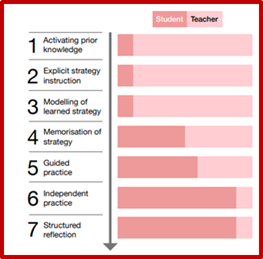Revisiting Cognitive Load Theory - Links to Embodied Cognition
.png)
As leaders and practitioners, we all appreciate the importance of continually reviewing developments in our field in order to ensure our practice remains relevant and maximises the learning outcomes of our pupils. Although Cognitive Load Theory (CLT) has been known and developed within the academic realm for several decades, it has only come to prominence in instruction in the last few years.
For anyone unfamiliar with CLT, it is in summary the understanding that everyone has a limited working memory capacity and therefore when teaching, we should be careful not to overload learners with additional or new information (be it visual, auditory or physical) during lesson delivery.
In Hanham, Alonso and Chen’s 2023 literature review, they noted that Pas and Sweller (2012) linked “embodied cognition” to CLT: this is “the use of object manipulation and gestures to optimize instruction”. In practical classroom terms, this can be seen in the form of the use of physical resources, modelling and scaffolding and shared practice. This features in the EEF’s 'Seven-Step Model' from its Metacognition and Self-Regulated Learning guidance:
 Modelling strategies may take the form of a teacher/teaching assistant modelling writing a text in English, demonstrating how to answer an exam question or how to use a particular arithmetical method etc on an interactive whiteboard, traditional whiteboard or large flip chart.
Modelling strategies may take the form of a teacher/teaching assistant modelling writing a text in English, demonstrating how to answer an exam question or how to use a particular arithmetical method etc on an interactive whiteboard, traditional whiteboard or large flip chart.
Hanham et al have isolated a specific variable in the best use of “embodied cognition”: viewing perspective. They have identified that learning is more effective when pupils are watching an “over the shoulder” perspective (first person), compared to face-to-face (third person) perspective, as the pupils themselves will be using the first perspective themselves when they engage in the activity. i.e. they see the model as they themselves will see it, which can aid understanding and application.
Interactive White Boards continue to be excellent learning tools but using a visualiser can be particularly useful to achieve this perspective, and it is also something to keep in mind when selecting video clips to supplement our lesson content or when demonstrating to our audience.
References:
Metacognition and Self-regulated Learning | EEF (educationendowmentfoundation.org.uk)
Hanham, J, Castro-Alonso, JC & Chen, O (2023). Integrating cognitive load theory with other theories, within and beyond educational psychology. British Journal of Psychology, 93 (Suppl. 2) 239-250.
Written by Vanessa Sullivan, Deputy Headteacher at St Peter’s CE V/C Primary School, Coggeshall
Read our other blog posts here.
